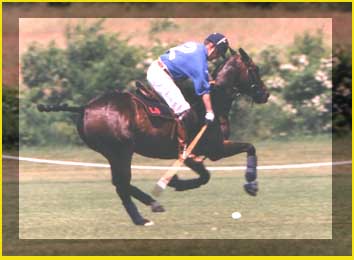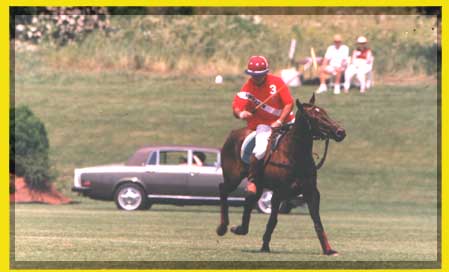 |
ABOUT POLO |
| POLO HISTORY |
|
Did you know ... that Polo is believed to be the oldest game in the world? It originated in Pakistan as a war game well over 2,500 years ago. The game taught warriors agility, quick thinking, and combative skills on horseback.
Today, like the warriors ages ago, people play the sport to test their horsemanship skills and athletic abilities. Game tactics are similar to soccer, hockey and football. However, it is the terrific speed combined with body contact and dartlike turns of the horses which gives polo its appeal to spectators and players alike |
| POLO FACTS |
|
1. The Polo field is 300 yards long by 160 yards wide - almost the size of nine football fields. 2. The mounts are called "polo ponies" although they are actually horses ranging from 14 to 16 hands high and weigh 900-1000 pounds. Most are between 5 and 15 years of age. A good horse can account for anywhere from 70-80% of a player's ability and net worth to his team.
4. Players are rated annually from minus 2 to 10 goals (the higher the better) by The United States Polo Association. The handicap of a team is the sum of its players. In handicap matches, the team with the higher rating gives the difference to the other team. For example, a 6 goal team will give 2 goals to a 4 goal team. The word goal has no relation to the amount of goals a player scores - only his ability 5. The equipment - Mallets are made of bamboo canes which provide flexibility and tapered heads of willow or maple. The ball is made of bamboo or widow root and weighs about 4' ounces. All players wear protective equipment. The horses also wear protective bandages on their legs and have their tail and mane braided to minimize interference in making the various shots. |
| HOW THE GAMES IS PLAYED |
| TEAM "A" Positions | VS. | TEAM "B" Positions |
| (1) | Stays out front to score goals or help teammate score | (4) |
| (2) | Places himself with range of # 3's shots so that he can pass ball to # 1, then follow the ball to cover # 1, or shoot for goal if ball is set up for him. | (3) |
| (3) | Should be the strongest player on the team - one who - can change places with # 4 and defend goal or go ahead of his # 2 and carry on offense up field. | (2) |
| (4) | Chiefly defensive - should have good back shots to head off plays toward his goal and clear the ball from that area | (1) |
| Since play is rapid, players should be able to interchange
positions as the situation demands. As a rule, the play is 4 vs 1; 3 vs 2;
2 vs 3; 1 vs 4.
|
 By 600
A.D., the game had spread to Persia, Constantinople and China. It faded
out around l500 but was revived in 1850 by the India Prince of Bengal. The
British adopted the game in 1859 and it made its way to the USA in 1876.
By 600
A.D., the game had spread to Persia, Constantinople and China. It faded
out around l500 but was revived in 1850 by the India Prince of Bengal. The
British adopted the game in 1859 and it made its way to the USA in 1876.
 3. The
player - Each team consists of four mounted players. The number 1 is
expected to score the goals and carry out an offensive position. The
number 2 is also an offensive player, but must aggressively break up the
defensive plays of the opposition. The number 3 is the pivot man and is
usually the long ball hitter and playmaker for the team. The number 4, or
back, is the defensive player. His job is to guard the goal and keep the
opposition from scoring.
3. The
player - Each team consists of four mounted players. The number 1 is
expected to score the goals and carry out an offensive position. The
number 2 is also an offensive player, but must aggressively break up the
defensive plays of the opposition. The number 3 is the pivot man and is
usually the long ball hitter and playmaker for the team. The number 4, or
back, is the defensive player. His job is to guard the goal and keep the
opposition from scoring.